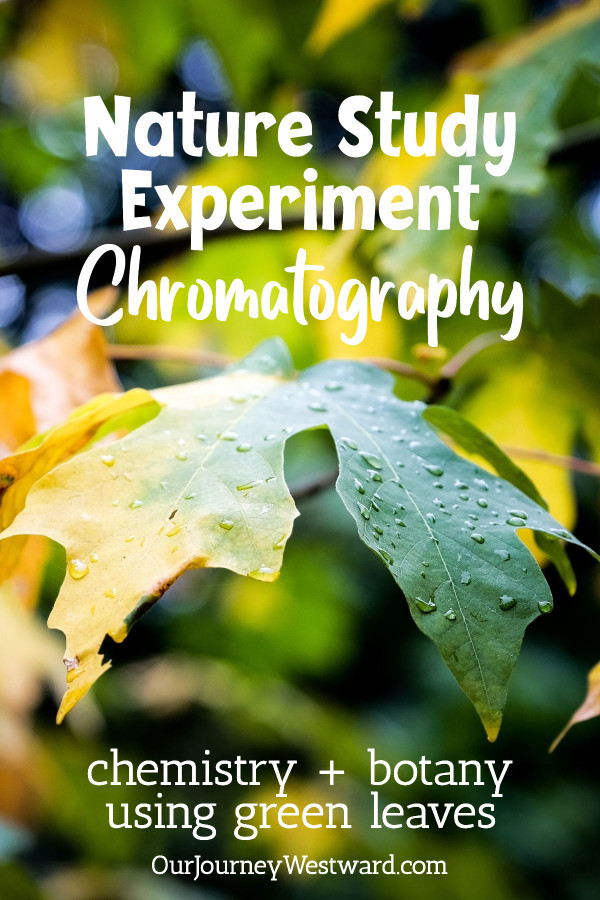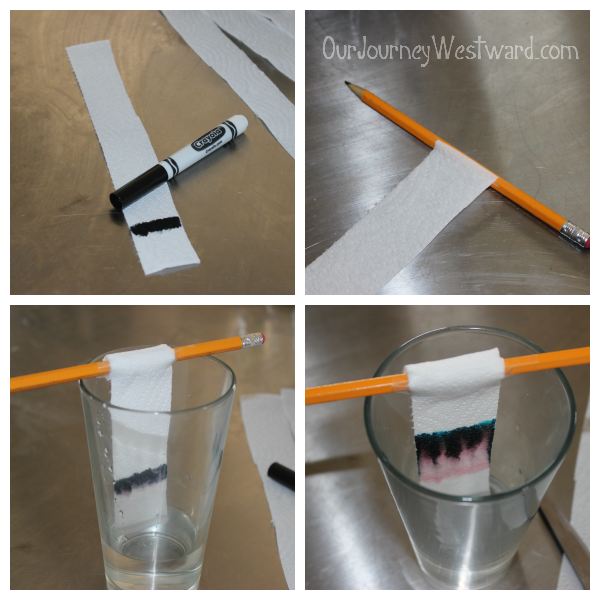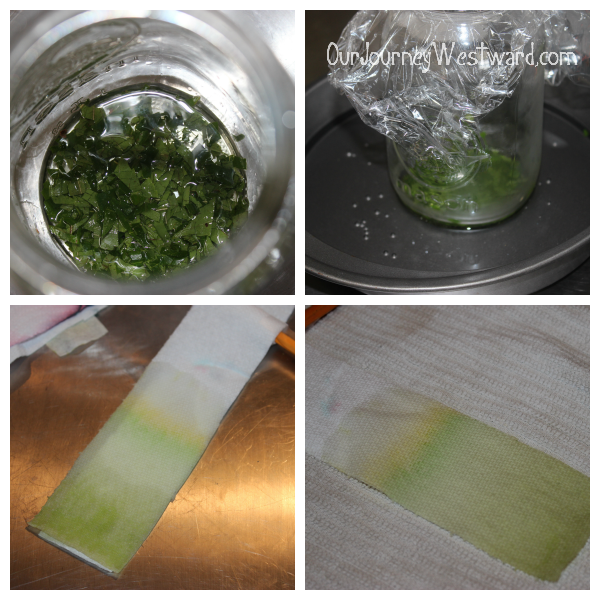Chromatography with Leaves: A Nature Study Experiment
This fun chromatography with leaves experiment will teach both the amazing chemistry of chromatography and the botany of why deciduous leaves change colors in autumn.

This post contains affiliate links.
What is chromatography?
It’s simply a big name that means separating mixtures. Or, in this case, separating pigments. As complicated as the word sounds, experimenting with chromatography is very easy.
Chromatography with Markers
I always like to teach the concept of chromatography with markers before using other materials because markers provide such consistently fantastic results.
Materials:
- black water-soluble markers (a variety of brands would be nice for comparison experiments)
- glasses filled with about 1″ of water
- white paper towels cut into 1″ strips
- pencils
- tape
The black ink you find in water-soluble markers is made from a variety of colored pigments. You can determine which pigments were used by separating the individual colors in this easy experiment.
On a strip of paper towel, use one of your markers to draw a thick line horizontally one inch from the bottom.
Tape the paper towel to a pencil.
Suspend the pencil across the glass so that the very bottom of your strip of paper towel touches the water.
Use other black markers (or experiment with other colored markers) to repeat the experiment using a new glass of water each time.
Observe the water as it slowly travels up the towel using a force called capillary action. As the water moves through the marker ink, you will notice it pulls and deposits various pigments up the towel. This happens because different colored pigments are carried along at different rates. How fast each pigment travels depends on the size of the pigment molecule and how strongly the pigment is attracted to the paper. As each pigment is deposited, you are able to see the various colors mixed to make the black ink. (This separation could take up to 30 minutes.)
Draw the various results in a science journal for comparison.

Chromatography with Leaves
Now that your children understand the concept of chromatography, you can try another experiment to get a sneak peek at the color of fall leaves.
I like to do this experiment in late summer or early fall just before leaves begin changing colors. We discuss photosynthesis, chlorophyll, and the true pigments of leaves first.

Materials:
- GREEN leaves
- rubbing alcohol
- glasses
- plastic wrap
- coffee filters or white paper towels cut into 1″ strips
- pencils
- tape
This experiment works a bit differently than the marker experiment and the results aren’t always quite as brilliant – especially if your leaves are dry from drought.
Tear one green leaf into very small bits and place the pieces in a glass.
Add enough rubbing alcohol to just cover the leaf pieces.
Cover the glass with plastic wrap and place it in a shallow pan of hot tap water. The hot water will help the alcohol absorb the leaf pigments. It should take about 30 minutes in the hot water for the alcohol to turn green. You may need to replace the hot water once and swirl the glasses a few times.
Tape a coffee filter or paper towel strip to a pencil.
Once the alcohol is green, suspend the pencil over the glass so that the very end of the paper strip barely touches the liquid.
It will take approximately an hour and a half for the pigments to travel up and separate on the paper.
Repeat the experiment several times with different leaves so you can make comparisons.
You should be able to see hints of the “real” colors of the leaves and make predictions about their fall colors.
Note all your findings in a science or nature journal.

More Chromatography Experiments
Here are two chromatography experiments that look like great fun. I think we’ll dive into the candy experiment next.
Chromatography Forensics Experiment
More Deciduous Tree Study
Deciduous trees are amazing to study in all seasons. In NaturExplorers Delightful Deciduous Trees, you will find enough nature walks and extension activity ideas to carry you through many, many fun, creative, and serious science lessons!

See More Tree Study Ideas




Rubbing alcohol is hard to find. Will this the leaf pigments still bleed with just water in the cup? Are there other substitutes for the rubbing alcohol that would work?
I’m not sure if substitutes would work or not. It’s the solvent that separates dyes that are not water soluble. It wouldn’t hurt to experiment with a different solvent like vinegar, nail polish remover, or even drinking alcohol. Of course, all of these (including the isopropyl alcohol) require parental supervision.